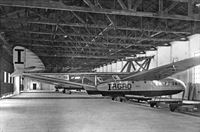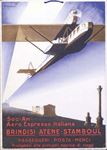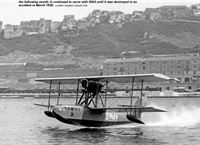Фотографии
-
Регистрационный номер: I-ABOR Bearing the legend “Aero Espresso Italiana” on the outer sides of its distinctive twin hulls, Savoia-Marchetti S.55C I-ABOR awaits its next flight. The machine joined the AEI fleet in August 1925, but had a short career, being lost in a crash crossing the Sea of Marmara on a service to Constantinople in September 1927.
Самолёты на фотографии: Savoia-Marchetti / SIAI S.55 - Италия - 1924
-
Регистрационный номер: I-AGRO Minus its tandem Isotta-Fraschini Asso 500 engines on the central pylon, S.55C I-AGRO (c/n 10505) undergoes maintenance at AEI’s workshops in Brindisi. This example, one of the five operated by AEI, fared slightly better than I-ABOR, serving the airline for eight years from March 1926 until its demise in a crash in August 1934.
Самолёты на фотографии: Savoia-Marchetti / SIAI S.55 - Италия - 1924
-
Регистрационный номер: I-BAZI [2], D-963 [2] Originally operated by Deutsche Luft Hansa as D-963, Junkers-G 24ge trimotor I-BAZI (c/n 947) was acquired by Transadriatica in April 1927 and was absorbed into the SAM fleet, along with G 24 I-BAUS, in late 1931.
Самолёты на фотографии: Junkers G 23 / G 24 - Германия - 1924
-
Регистрационный номер: I-BAUS One of Transadriatica’s two Junkers-G 24 trimotors, I-BAUS (c/n 924) awaits its next flight at Vienna’s Aspern airport. In December 1931 Transadriatica was taken over by SAM, both G 24s and eight F 13s being subsumed into the latter’s fleet.
Самолёты на фотографии: Junkers G 23 / G 24 - Германия - 1924
-
Регистрационный номер: I-BAZI [2], D-963 [2] Самолёты на фотографии: Junkers G 23 / G 24 - Германия - 1924
-
Регистрационный номер: I-BATB Junkers-F 13 I-BATB (c/n 778) joined the Transadriatica fleet in August 1926 and flew the new airline’s inaugural service, from Venice to Vienna via Klagenfurt, on the 26th of that month.
Самолёты на фотографии: Junkers F 13 - Германия - 1919
-
The Junkers-F 13 was an advanced design for its day and could accommodate four passengers (and evidently a baby as well!) in the enclosed cabin and two crew in the open cockpit. Using Junkers-F 13s and G 24s, Transadriatica had expanded its services as far north as Vienna and Munich and as far south as Brindisi by mid-1928.
Самолёты на фотографии: Junkers F 13 - Германия - 1919
-
Регистрационный номер: I-BAUV In December 1926 AEI acquired a pair of Savoia S.16ter five-seat flying-boats, I-BAUT (c/n 5148) and I-BAUV (c/n 5129). The latter is seen here undergoing maintenance on its single 400 h.p. Isotta-Fraschini-built Lorraine-Dietrich pusher-configured engine. The passengers and crew were accommodated in two open cockpits forward of the wings.
Самолёты на фотографии: SIAI S.16 / S.53 - Италия - 1919
-
In 1931 SANA ordered two examples of Dornier’s massive Do X, powered by 12 Fiat A.22R 12-cylinder water-cooled engines. The Italian Do Xs were intended to be used on a prospective route from Trieste to Cadiz in Spain via Genoa, Marseille and Barcelona, but they never entered service with SANA and were ultimately scrapped.
Самолёты на фотографии: Dornier Do.X - Германия - 1929
-
Регистрационный номер: I-AZDH Dornier Wal Cabina I-AZDH was acquired by AEI in September 1927 and served with the airline until it was written off after being damaged by fire in Mytilene Harbour on Lesbos on June 10, 1930. In the summer of 1934 AEI was one of the airlines that, in concert with SISA, SANA and SAM (incorporating Transadriatica), formed Ala Littoria.
Самолёты на фотографии: Dornier Do.J Wal - Германия - 1922
-
Регистрационный номер: I-AZDI Italy became the biggest operator of passenger-configured Dornier Wals, with some 26 being used on the early Italian air services. Built in numerous variants, the Wal was powered by various engines, this Piaggio-built example, I-AZDI of SANA, being fitted with a pair of Bristol Jupiter IVs in the type’s distinctive tandem configuration.
Самолёты на фотографии: Dornier Do.J Wal - Германия - 1922
-
Самолёты на фотографии: Dornier Do.J Wal - Германия - 1922
-
Самолёты на фотографии: Dornier Do.J Wal - Германия - 1922
-
Регистрационный номер: I-REOS "GRAF ZEPPELIN": The new Zeppelin airship L.Z.127, which has just accomplished a record flight from Germany to Lakehurst, N.J., flying over Lake Constance during her trials. In the foreground is a Dornier "Super-Wal" (four Bristol "Jupiters") flying boat.
Powered by four Gnome-Rhone-built Jupiter engines in paired tandem configuration, Dornier Super Wal I-REOS (c/n 144) was one of six operated by SANA from October 1928 and served with the airline until it was destroyed in May 1934. The other SANA Super Wals were I-RATA (c/n 145), I-RENE (c/n 141), I-RIDE (c/n 142), I-RONY (c/n 170) and I-RUDO (c/n 171).Самолёты на фотографии: Dornier Do.R Super Wal - Германия - 1926
-
Регистрационный номер: I-RENE Super Wal I-RENE was one of the first two delivered to SANA in late 1928, and operated with the company until it was withdrawn from use in June 1930. The Super Wal was a larger version of the Wal, with a 93ft 6in (28-5m) - span wing of metal two-spar structure with a smooth duralumin leading edge and fabric-covered trailing edge.
Самолёты на фотографии: Dornier Do.R Super Wal - Германия - 1926
-
Регистрационный номер: I-AANM During 1929-30 a modified version of the CANT 10ter was developed with a metal hull with duralumin sheet skin and redesigned bows. A two-seat cockpit with side-by-side seating was incorporated and the wooden-hulled 10ter’s five passenger cabin windows were replaced with two larger windows. This is one of the first two.
Самолёты на фотографии: CANT CANT 10 - Италия - 1925
-
Регистрационный номер: I-AASH CANT 10ter I-AASH (c/n 206) of SISA at Fiume, located in Kvarner Bay, an inlet of the Adriatic, now the main seaport and third-largest city in Croatia. This machine was delivered in December 1930 and was one of the batch of four metal-hulled examples delivered to SISA from the summer of that year.
Самолёты на фотографии: CANT CANT 10 - Италия - 1925
-
Регистрационный номер: I-OLTE Seen here “on the step” at Trieste, CANT 10ter I-OLTE (c/n 5) was acquired by SISA in March 1926 and operated the first Turin-Trieste service for the airline the following month. It continued to serve with SISA until it was destroyed in an accident in March 1932.
Самолёты на фотографии: CANT CANT 10 - Италия - 1925
-
Регистрационный номер: I-ALFA CANT 22 I-ALFA (c/n 230) was named San Sergio in SISA service and joined the company in June 1931. An unequal-span biplane with a single-step wooden hull and single fin and rudder, the type was fitted with two side-by-side cockpits situated midway between the wings and the bow.
Самолёты на фотографии: CANT CANT 22 - Италия - 1928
-
Регистрационный номер: I-AABN In 1928 SISA took delivery of I-AABN, its first example of the three-engined CANT 22, powered by a trio of 200 h.p. Isotta-Fraschini Asso 200 six-cylinder inline engines in tractor configuration. Named San Marco in SISA service, I-AABN was later absorbed into the state-owned Societa Aerea Mediterranea and ultimately, Ala Littoria.
Самолёты на фотографии: CANT CANT 22 - Италия - 1928
-
The passenger cabin was aft of the cockpits and incorporated three large rectangular windows in each side. The CANT 22 was comfortable and operated on SISA’s Trieste-Genoa and Trieste-Ancona routes.
Самолёты на фотографии: CANT CANT 22 - Италия - 1928
Статьи
- -
- A.Tincopa - Wings over Peru
- B.Turpin - Brief encounter
- F.Villeneuve - Hawk One (1)
- J.-C.Carbonel - France's Air Pioneers: Louis Damblanc
- K.Hayward - AFVG "A political problem for both sides..."
- L.Andersson - Dirty secrets
- M.Wickstead - Italy's forgotten airlines (1)
- P.Davidson - Off the Beaten Track...
- P.Jarrett - Lost & Found
- P.Lewis - Switzerland's Tiger Force
- P.Vabre - From Flying to Spying (2)
- T.Culbert - The Hump pioneers
- U.Vicenzi - "The most important Bristol engine of all time"




















